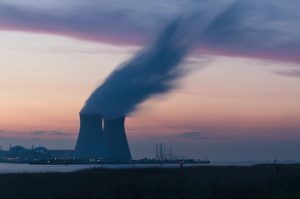Even though I knew for months that an ESG firm was thinking about removing its exclusion on nuclear power producers, I was taken aback when I read their press release. Why would they revert their position and turn to nuclear when investing in renewable energy has grown so dramatically?
In reading their statement, I didn’t find any satisfactory explanations. Yet this sentence struck me: “We believe nuclear energy offers a critical source of fuel, with benefits that include … safety.” Safety. Let’s start with that.
Safety. The designs for nuclear plants are varied, and there is no guarantee that the reactors will be designed, built, and operated correctly or that a natural disaster, such as the earthquake and tsunami with 30-foot waves that hit the Fukushima Daiichi Nuclear Power Station won’t affect it given the increased frequency and intensity of storms due to climate change. In contrast, wind turbines pose none of these dangers but may pose other potential drawbacks. There also are costs associated with meltdown, mining lung cancer, and waste. Clean, renewables can help reduce such risks.
Cost. Nuclear power is among the costliest approaches to solving America’s energy problems. New nuclear power costs about five times more than onshore wind power per kilowatt hour. Per dollar of investment, clean energy solutions – such as energy efficiency and renewable resources – deliver far more energy than nuclear power.
Timing. Nuclear takes 5-to-17 years longer between planning and operation than renewable energy does.
Emissions. Supporters claim these plants can deliver energy with no carbon emissions but there is no such thing as a zero-emission nuclear power plant. Emissions from nuclear plants are on average 23 times the emissions per unit of electricity generated. Even existing plants emit due to the continuous mining and refining of uranium needed for the plant.
Waste. The radioactive waste from nuclear power plants stays radioactive for decades and is typically stored in temporary facilities. But even those storage spaces are running out and the industry is turning to more costly options.
Reducing emissions is critical and that’s why I believe sustainable investors should keep nuclear out of responsible and green investing, and instead support the clean renewable energy sector.
Globally, renewables account for about one third of electricity generation—and renewable capacity will meet 35% of global power generation by 2025, according to the International Energy Agency (IEA) . The global energy crisis has triggered unprecedented momentum behind renewables, with the world set to add as much renewable power in the next 5 years as it did in the past 20.
We believe the considerable human and environmental safety issues involved with building and running nuclear plants, as well as the lessons from Chernobyl, Three Mile Island and Fukushima must not be forgotten.
Why gamble with the environmental and public health risks of it – especially when renewable energy is cleaner and cost competitive. I’m proud that the Green Century Funds have excluded nuclear energy for more than two decades, offering a true path toward a safer planet, and we have no plans to change our commitment.
An investment strategy that incorporates environmental, social and governance criteria may result in lower or higher returns than an investment strategy that does not include such criteria.
Leslie Samuelrich
President, Green Century Funds
°Green Century Capital Management, Inc. (Green Century) is the investment advisor to the Green Century Funds (the Funds).
The Green Century Funds are a family of fossil fuel-free, environmentally responsible mutual funds. Green Century Capital Management hosts an award-winning and in-house shareholder advocacy program and is the only mutual fund company in the U.S. wholly owned by environmental and public health nonprofit organizations.
You should carefully consider the Fund’s investment objectives, risks, charges, and expenses before investing. To obtain a Prospectus that contains this and other information about the Funds please visit www.greencentury.com, email info@greencentury.com, or call 1-800-934-7336. Please read the Prospectus carefully before investing.
Stocks will fluctuate in response to factors that may affect a single company, industry, sector, country, region or the market as a whole and may perform worse than the market. Foreign securities are subject to additional risks such as currency fluctuations, regional economic and political conditions, differences in accounting methods, and other unique risks compared to investing in securities of U.S. issuers. Bonds are subject to a variety of risks including interest rate, credit, and inflation risk. A sustainable investment strategy which incorporates environmental, social and governance criteria may result in lower or higher returns than an investment strategy that does not include such criteria.
This information has been prepared from sources believed reliable. The views expressed are as the date of this writing and are those of the Advisor to the Funds.
The Green Century Funds are distributed by UMB Distribution Services, LLC. 235 W Galena Street, Milwaukee, WI 53212. 9/23. UMB and Green Century are not affiliated.



